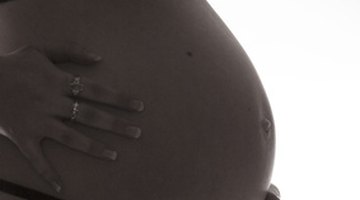Causes of Pelvic Pressure When 33 Weeks Pregnant
Dramatic weight gain--between 25 and 40 lbs. in a healthy pregnancy--and fluctuating hormones are the cause of a variety of pregnant womenâ?
?s complaints, including pelvic pressure.
A pregnancy lasts between 37 and 42 weeks, so at 33 weeks, the end is near and the pelvic pressure more intense. In most cases, pelvic pressure is not serious. Nevertheless, women should report any symptoms to a doctor or midwife immediately, because rarely, it can indicate an emergency.
Early Labor
Pelvic pressure can be a sign of early labor. At only 33 weeks gestation, however, the baby is more than a full month early and requires intensive care upon birth.
In some cases, if premature labor is caught early enough, it can be stopped with medication and bed rest. According to the American Pregnancy Association, if any of the following symptoms accompany pelvic pressure, early labor is the likely culprit: increased vaginal fluid or discharge, low back pain, abdominal cramps or menstrual-like pain.
Lightening

12 Weeks Pregnant Symptoms
Learn More
In the weeks before labor, the baby usually drops deeper in the pelvis, causing added pressure. According to Babycenter.com, this can happen as many as four weeks before labor actually begins, so for a term pregnancy at 37 weeks, it is possible to experience lightening at 33 weeks.
If lightening has occurred, pregnant women may find it easier to breathe, as the pressure of the baby is off their lungs.
The pregnancy bump may visibly shift downward, causing some pregnant women to waddle. Usually lightening is accompanied by an increased need to urinate.
Sciatica
Sciatica is a sharp pain that may be felt in the pelvis, legs and lower back. Lying on one side for an extended period of time may aggravate sciatica.
Pregnant women should rest with a wedge, bolster or body pillow between their legs to prevent them from collapsing on each other and putting undue pressure on the pelvis. Mothering recommends the yoga pose janu sirasana, or head-on-knee pose, for sciatica.
Symphysis Pubic Dysfunction

Shooting Pains at Four Months Pregnant
Learn More
Approximately 45 percent of pregnant woman suffer from symphysis pubic dysfunction, or SPD, according to the Pelvic Instability Network. These women produce an excess of the hormone relaxin, which is responsible for loosening the joints. The result is intense pain in the pelvic region as ligaments stretch and bones move outward. Pelvic support belts, Kegels and pelvic-tilt exercises all help relieve the symptoms of SPD.











